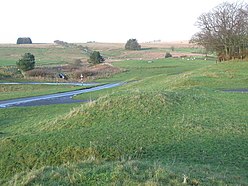Bewcastle Roman Fort
| Bewcastle Roman Fort | |
|---|---|

Ramparts of the Roman fort at Bewcastle
|
|
| Known also as | Fanum Cocidi |
| Coordinates | 55°03′50″N 2°41′06″W / 55.064°N 2.685°W |
| County | Cumbria |
| Country | England |
| UK-OSNG reference | NY563745 |
Bewcastle Roman Fort was a Roman fort, built to the north of Hadrian's Wall as an outpost fort and intended for scouting and intelligence. The Roman name for the fort was Fanum Cocidi (as recorded in the Ravenna Cosmography), and means 'The Shrine of Cocidius', a deity worshipped in northern Britain. The remains of the fort are situated at the village of Bewcastle, Cumbria, 7 miles (11 km) to the north of the Roman fort at Birdoswald, on Hadrian's Wall.
The fort was identified as Fanum Cocidi on the basis that, of nine altars discovered on the site, six are dedicated to the god Cocidius.
The fort was unusual for a Roman fort, being an irregular hexagon rather than oblong, and occupied the whole of the small plateau on which it stood. It occupied an area of almost 6 acres (24,000 m2). The fort was connected to Banna by a Roman road known as the Maiden Way. Two stone signalling towers have been discovered between the two forts (at Barron’s Pike and Robin Hood’s Butts), and it is believed that these were used to pass on signals from Bewcastle to Birdoswald.
It is believed that the fort was built at about the same time as the forts on Hadrian's Wall, and that it was originally built with turf defences and timber buildings, but with gates and headquarters of stone. During the Antonine period, the turf ramparts were faced with stone. It was later completely rebuilt in stone. There were gateways to the north, south, east and west, the west gateway being the main one. The commandant’s house (praetorium) was in the approximate centre of the hexagon, with the headquarters (principia) to the immediate north of it. A Hadrianic-style bathhouse was situated in the south-east section of the fort.
Building inscriptions found at the site indicate that detachments from at least three legions were involved in the building of the fort, the Second Legion (stationed at Caerleon in Wales), the Sixth Legion (based in York) and the Twentieth Legion (based in Chester).
...
Wikipedia

